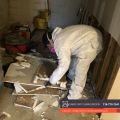Dealing With Mold After Water Damage: A Step-by-Step Plan

Water damage in a home or commercial property is more than just an inconvenience—it’s a gateway for mold growth. Within 24 to 48 hours of a flood, leak, or burst pipe, mold spores can settle into damp materials and begin spreading. If not addressed quickly, this can lead to structural damage and serious health concerns.
For property owners in the Bay Area, professional mold inspection and mold testing services are the key to protecting both health and property. Certified mold inspector Rick Bruce and his team at Bay Area Mold Pros specialize in identifying and addressing mold before it spirals out of control.
Here’s a step-by-step plan for dealing with mold after water damage, followed by real stories of how prompt action helped homeowners recover.
Step 1: Address the Water Source Immediately
Before tackling mold, you must stop what’s feeding it. Whether it’s a burst pipe, leaky roof, or flooded basement, cut off the water source and begin drying the area as quickly as possible. Use pumps, wet vacuums, or professional drying equipment if necessary.
Step 2: Dry and Ventilate the Area
Mold thrives in damp, stagnant environments. Open windows and doors for ventilation, use fans to circulate air, and run dehumidifiers to reduce humidity levels. Materials like drywall, carpeting, and insulation that remain wet for more than 48 hours are highly susceptible to mold growth.
Step 3: Inspect for Mold Growth
Even if surfaces look dry, mold can grow behind walls, under floors, and inside HVAC systems. Look for discoloration, musty odors, or water stains. Because mold can be hidden, scheduling a professional mold inspection ensures that no contaminated areas go unnoticed.
Step 4: Mold Testing for Safety
Not all molds are the same. Some are relatively harmless, while others, such as black mold (Stachybotrys chartarum), release toxins that can affect your health. Mold testing identifies the type and concentration of mold spores, helping you understand the risks and determine the right remediation strategy.
Step 5: Remove Contaminated Materials
Porous materials like drywall, carpet, and insulation often cannot be salvaged once mold sets in. Removing and safely disposing of them is crucial to prevent further contamination. Hard surfaces can sometimes be cleaned with antimicrobial solutions, but professional guidance is essential to ensure mold doesn’t return.
Step 6: Professional Remediation and Prevention
DIY cleanup may address surface mold, but without proper remediation, spores can linger and grow back. Certified professionals like Rick Bruce at Bay Area Mold Pros not only remove existing mold but also identify and fix the underlying causes. They may recommend improvements like better ventilation, sealing leaks, or installing dehumidifiers to keep your property mold-free long term.
Real Stories: How We Beat Mold After a Burst Pipe
To better understand the process, let’s look at a real case handled by Bay Area Mold Pros.
A Bay Area homeowner returned from vacation to find their kitchen flooded due to a burst pipe under the sink. While the water was quickly shut off, moisture had already seeped into the walls, flooring, and cabinets. Within three days, dark patches appeared along the baseboards, and a musty odor filled the house.
The homeowner called Bay Area Mold Pros. Rick Bruce performed a mold inspection and testing, which revealed both surface mold and hidden growth inside the walls. His team removed contaminated drywall, treated affected surfaces with antimicrobial solutions, and used industrial-grade dehumidifiers to dry the structure thoroughly.
Just as important, Rick advised on preventive measures, such as adding a moisture sensor and improving under-sink ventilation. Thanks to prompt action, the homeowner avoided widespread damage and restored their property safely.
Protecting Your Property After Water Damage
Water damage is stressful, but ignoring the risk of mold makes the situation worse. With the right step-by-step plan—addressing the water source, drying, inspecting, testing, removing contaminated materials, and seeking professional help—you can protect both your health and your property.
For Bay Area property owners, the best way to ensure mold is handled thoroughly and safely is to call in professionals.
Request an inspection today at (650) 762-6228 with Bay Area Mold Pros. Led by certified mold inspector Rick Bruce, the team provides expert mold inspection and mold testing services tailored to your needs. Visit bayareamoldpros.com






